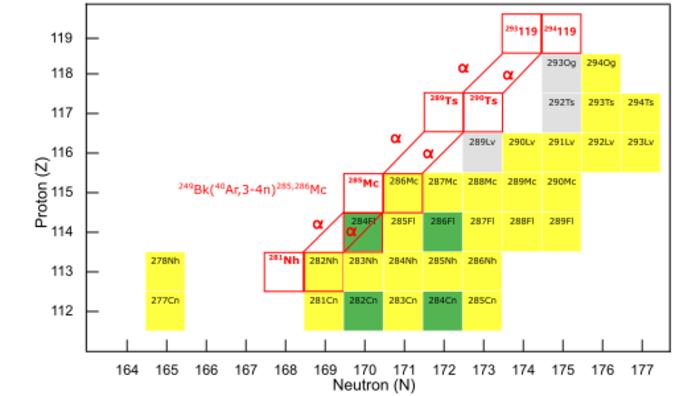In the relentless pursuit of uncovering the heaviest and most elusive elements in the periodic table, a groundbreaking study proposes a radical shift in the synthetic approach to superheavy elements beyond uranium. Traditionally, the production of these fleeting giants has relied heavily on fusion reactions initiated by calcium-48 (⁴⁸Ca) beams, a method known for its effectiveness but also for its considerable cost and technical complexity. However, researchers Jia-Xing Li and Professor Hong-Fei Zhang from Xi’an Jiaotong University have introduced an innovative alternative: employing argon-40 (⁴⁰Ar) as the projectile in fusion reactions. This novel strategy, underpinned by comprehensive computational simulations, promises not only to lower production costs but also to potentially enhance the efficiency of synthesizing superheavy nuclei.
Superheavy elements, occupying the farthest reaches of the periodic table, are synthesized by bombarding heavy target nuclei with lighter ions in particle accelerators. The creation of such nuclei depends on delicate fusion-evaporation processes, where the amalgamation of two atomic nuclei forms a compound nucleus that subsequently sheds excess energy via particle evaporation. Historically, calcium-48 beams have been favored due to their high neutron richness and favorable reaction dynamics, leading to relatively higher evaporation residue cross sections. Nevertheless, the scarcity and expense of ⁴⁸Ca have constrained extensive exploration, particularly in producing elements heavier than those currently known.
The study meticulously investigates the potential of ⁴⁰Ar, a more abundant and cost-effective isotope, to serve as a viable projectile in these fusion reactions. Using advanced theoretical models, the researchers analyzed each critical phase of the fusion-evaporation sequence—capture, fusion, and survival—unveiling that reactions involving ⁴⁰Ar can rival or even surpass the evaporation residue cross sections obtained with ⁴⁸Ca. Strikingly, these reactions require notably lower beam energy, a factor that could significantly reduce operational costs and experimental complexity.
A pivotal focus of the research lies in identifying pathways to synthesize isotopes pertinent to the alpha decay chain of the hypothesized element 119, a superheavy nucleus yet to be confirmed experimentally. The authors propose the reaction between ⁴⁰Ar and berkelium-249 (²⁴⁹Bk) targets as a promising avenue for producing moscovium-286 (²⁸⁶Mc), an isotope vital to tracing the decay sequences leading to element 119. Their calculations estimate the evaporation residue cross section for this reaction at approximately 7.9 picobarns, a relatively high value that improves the prospects for successful experimental synthesis.
One of the key insights derived from the fusion process analysis relates to the influence of mass asymmetry between the projectile and target nuclei. The asymmetry inherent in the ⁴⁰Ar + ²⁴⁹Bk system appears to lower the inner fusion barrier, thereby enhancing the fusion probability. This dynamic contrasts with reactions involving ⁴⁸Ca, where the near symmetry can sometimes hinder compound nucleus formation. Consequently, the ⁴⁰Ar-based reactions demonstrate a favorable balance of capture efficiency and compound nucleus survival, both critical for maximizing superheavy element yields.
The computational framework employed in this work integrates models for nuclear reaction dynamics and statistical decay, enabling an in-depth evaluation of fusion probabilities and survival rates against fission. Through this multifaceted approach, the team delineated how differences in nuclear structure and reaction energetics between ⁴⁰Ar and ⁴⁸Ca influence the overall synthesis process. The findings not only underscore the feasibility of ⁴⁰Ar projectiles but also reveal nuanced mechanisms that could guide future experimental designs.
Professor Zhang emphasizes the broader implications: “The use of ⁴⁰Ar opens an exciting frontier for superheavy element research. Its affordability combined with competitive or superior reaction dynamics challenges the prevailing reliance on ⁴⁸Ca and could reshape the strategic planning of upcoming synthesis experiments.” Such a development may accelerate the discovery timeline for elements that inch closer to the theorized “island of stability,” where superheavy nuclei are predicted to exhibit relatively longer lifetimes.
Aside from practical advantages, this shift could invigorate theoretical and experimental collaborations worldwide by diversifying the methodological toolkit available for nuclear chemistry and physics. The prospect of employing ⁴⁰Ar also alleviates supply bottlenecks inherent to ⁴⁸Ca, whose production is limited and operationally demanding. Researchers will be able to conduct more varied and extensive studies, improving statistical significance and exploration depth in synthesizing yet-undiscovered nuclei.
Moreover, the investigation highlights the intricate interplay between nuclear shell effects, deformation parameters, and reaction kinetics that govern fusion outcomes. The synthesis of superheavy nuclei hinges not merely on projectile choice but on optimizing the entire fusion landscape to maximize compound nucleus formation and survival. This comprehensive understanding, bolstered by simulations, will refine target-projectile combinations and beam parameters for future experiments.
Notably, the study’s predictions provide a crucial theoretical guidepost for experimentalists working in accelerator facilities globally. The calculated cross sections and reaction conditions furnish benchmarks that can focus resources efficiently, mitigating the trial-and-error nature typical of superheavy element discovery campaigns. Furthermore, understanding the alpha decay chains—as in the case of the newly proposed isotopes of element 119—yields essential decay markers crucial for verifying the creation of these ephemeral nuclei.
This research appears in the peer-reviewed journal Nuclear Science and Techniques, with a publication date slated for June 9, 2025. It represents a significant step toward unlocking the upper limits of the periodic table and enriches the collective knowledge concerning nuclear stability and synthesis at extreme atomic numbers. As more laboratories adopt this innovative approach, the dream of discovering element 119—and beyond—edges closer to reality, heralding new chapters in nuclear physics and chemistry.
The fusion community is abuzz with anticipation as computational insights on ⁴⁰Ar’s role inspire fresh experimental campaigns. Should empirical results align with theoretical predictions, ⁴⁰Ar could become the projectile of choice, catalyzing an era of discovery that transcends current constraints. This paradigm shift not only challenges long-held assumptions but also exemplifies the power of computational modeling in pioneering frontier scientific breakthroughs.
Image Credit: Hong-Fei Zhang
Subject of Research: Not applicable
Article Title: Exploring the synthesis of key superheavy nuclei using 40Ar as the projectile
News Publication Date: 9-Jun-2025
Web References: 10.1007/s41365-025-01719-y
Image Credits: Hong-Fei Zhang
Keywords
Fusion reactors, Nuclear change




